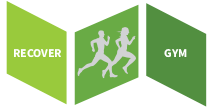The most stable area of the back is by far the vertebrae thoracicae. It’s put together well by ligaments and bone structure. Not to mention the extra stability given by the ribs between the vertebrae brings, that make the area more stable.
This means the mobility area of movement is limited, but the stability is far greater. This also means the muscles don’t have the same priority as other parts of the body. Frequent injuries in the vertebrae thoracicae area are due to tissue.
This can be due to crookedness which makes the back look like a C or a S or it can be due to adhesions between two or more vertebrates. The reason for stability in the chest area is to serve as protection of vital inner organs.

Find your injury in the list below:
Upper crossed syndrome (Chest-Neck-Shoulder imbalance)
- Bursae problems in the shoulder.
- Neck pain.
- Headache.
- Radiating symptoms in the arms etc.
- Impingement syndrome in the shoulder.
Thoracic Outlet Syndrome / TOS (chest/neck nerve impingement)
- Pain in shoulder and neck.
- Pain in arm.
- Pain in hand.
- Sleeping, pricking and stabbing sensations into the hand.
- Skin color change in hand and arm.
- Cold hand.
- Weak pulse in arm and hand.
- Weak gripping strength in hand.
- A pounding sensation at the collar bone.
- In the worst case a blood clot under the collar bone.
Morbus Scheuermann’s Disease
- Fatigue in the spine by exertion, for example sitting in school a whole day.
- Weakness and pain associated with exertion of the back / spine
- Changes in the normal curvature of the spine.
Symptoms of growth-related lumbar spine (Adolescent idiopathic scoliosis)
- The shoulders are asymmetrical.
- It is difficult to stand up straight.
- If one shoulder blade is more posterior.
- The rib arch is asymmetrical.
- The flank (side of the body) has a fold on one side which is not on the other.
- If the pelvis is pushed forward, the back will be asymmetrical.
- An abnormal gait pattern.

Social Medier